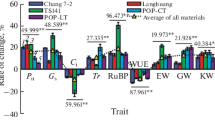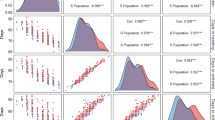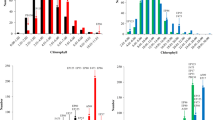Abstract
Variation in tolerance in chilling-dependent photoinhibition has been associated with a wide range of traits in comparative physiological studies. A sweet corn (Zea mays L.) population of 214 F2:3 families previously mapped to near-saturation with 93 RFLP DNA markers were subjected to low temperature and high-light events prior to measurement of the maximum dark-adapted quantum efficiency of PS II (F v /F m ), to identify loci associated with variation in chilling-dependent photoinhibition. In the first assay with ten families varying in seedling growth and germination, significant differences were observed among families in their response to and recovery from exposure to high light at low temperature. All the 214 F2:3 families from this population were then evaluated for tolerance of chilling-dependent photoinhibition in a controlled environment and then in three replicated trials in the field, each following naturally occurring chilling events during spring. The measured effects on F v /F m were analyzed with software that mapped segregating loci that regulate trait expression and linked to genetic markers (PLABQTL). QTL 3.096 (i.e. 96 cM on chromosome three) was consistently identified in both controlled environment and in the mean of the three field trails. Another QTL at 8.025, described the greatest percentage of total phenotypic variance (ca. 10%) for the mean reduction in F v /F m of all three periods of measurement in the field. A third QTL (4.136) showed a highly significant association in the third field trial. These three QTLs were closely associated with genes that have been mechanistically related to photoinhibition tolerance and repair. The results suggest that the ratio of F v /F m is an approach that may be used in establishing marker-assisted breeding for improved tolerance to chilling of maize in the light and in turn better early-season growth in cool temperate climates.
Similar content being viewed by others
Abbreviations
- F v /F m :
-
ratio of variable to maximal fluorescence of PS II; representing the dark-adapted maximum efficiency of PS II photochemistry
- LOD:
-
logarithm of the odds ratio, a measure of the probability of linkage
- PPFD:
-
photosynthetic photon flux density
- QTL:
-
quantitative trait loci
- RFLP:
-
restriction fragment length polymorphism
References
C Aguilera CM Stirling SP Long (1999) ArticleTitleGenotypic variation within Zea mays for susceptibility to and rate of recovery from chilling-induced photoinhibition of photosynthesis Physiol Plant 106 429–436 Occurrence Handle10.1034/j.1399-3054.1999.106411.x
F Azanza Y Tadmor BP Klein TR Rocheford JA Juvik (1996) ArticleTitleQuantitative trait loci influencing chemical and sensory characteristics of eating quality in sweet corn Genome 39 40–50
NR Baker (1996) Photoinhibition of photosynthesis RC Jennings G Zucchelli F Ghetti G Colombetti (Eds) Light as an Energy Source and Information Carrier in Plant Physiology Plenum Press New York 89–97
NR Baker M Bradbury PK Farage CR Ireland SP Long (1989) ArticleTitleMeasurements of quantum yield of carbon assimilation and chlorophyll fluorescence for assessment of photosynthetic performance of crop plants in the field Phil Trans Roy Soc B 323 295–308
NR Baker TM East SP Long (1983) ArticleTitleChilling damage to photosynthesis in young Zea mays. 2. Photochemical function of thylakoids in vivo J Exp Bot 34 189–197
NR Baker SP Long DR Ort (1988) The effects of temperature on photosynthesis SP Long FI Woodward (Eds) Plants and Temperature Cambridge University Press Cambridge 347–375
R Bassi S Caffarri (2000) ArticleTitleLhc proteins and the regulation of photosynthetic light harvesting function by xanthophylls Photosynth Res 64 243–256 Occurrence Handle10.1023/A:1006409506272
HR Bolhár-Nordenkampf SP Long NR Baker G Oquist U Schreiber EG Lechner (1989) ArticleTitleChlorophyll fluorescence as a probe of the photosynthetic competence of leaves in the field - a review of current instrumentation Funct Ecol 3 497–514
S Caffarri R Croce L Cattivelli R Bassi (2004) ArticleTitleA look within LHCII: differential analysis of the Lhcbl−3 complexes building the major trimeric antenna complex of higher-plant photosynthesis Biochemistry 43 9467–9476 Occurrence Handle10.1021/bi036265i Occurrence Handle15260489
JW Dudley (1993) ArticleTitleMolecular markers in plant improvement: manipulation of genes affecting quantitative traits Crop Sci 33 660–668
PK Farage SP Long (1987) Damage to maize photosynthesis in the field during periods when chilling is combined with high photon fluxes J Biggins (Eds) Progress in Photosynthesis Research NumberInSeriesVol 4 Martinus Nijhoff Dordrecht, The Netherlands 139–142
S Felder K Meierhoff AP Sane J Meurer C Driemel H Plucken P Klaff B Stein N Bechtold P Westhoff (2001) ArticleTitleThe nucleus-encoded HCF107 gene of Arabidopsis provides a link between intercistronic RNA processing and the accumulation of translation-competent psbH transcripts in chloroplasts Plant Cell 13 2127–2141 Occurrence Handle10.1105/tpc.13.9.2127 Occurrence Handle11549768
DB Fowler AE Limin JT Ritchie (1999) ArticleTitleLow-temperature tolerance in cereals: model and genetic interpretation Crop Sci 39 626–633
B Genty J-M Briantais NR Baker (1989) ArticleTitleThe relationship between the quantum yield of photosynthetic electron transport and quenching of chlorophyll fluorescence Biochim Biophys Acta 990 87–92
DA Heck D Miles PR Chitnis (1999) ArticleTitleCharacterization of two photosynthetic mutants of maize Plant Physiol 120 1129–1136 Occurrence Handle10.1104/pp.120.4.1129 Occurrence Handle10444096
MR Hull SP Long LS Jahnke (1997) ArticleTitleInstantaneous and developmental effects of low temperature on the catalytic properties of antioxidant enzymes in two Zea species Austr J Plant Physiol 24 337–343
LS Jahnke MR Hull SP Long (1991) ArticleTitleChilling stress and oxygen metabolizing enzymes in Zea mays and Zea diploperennis Plant Cell Environ 14 97–104
AH Kingston-Smith CH Foyer (2000) ArticleTitleOverexpression of Mn-superoxide dismutase in maize leaves leads to increased monodehydroascorbate reductase, dehydroascorbate reductase and glutathione reductase activities J Exp Bot 51 1867–1877 Occurrence Handle10.1093/jexbot/51.352.1867 Occurrence Handle11113165
A Laisk V Oja (1998) Dynamics of leaf photosynthesis. Rapid-response measurements and their interpretations. Techniques in Plant Sciences. No. 1. CSIRO Collingwood Australia
R Lander D Botstein (1989) ArticleTitleMapping Mendelian factors underlying quantitative traits using RFLP linkage maps Genetics 121 185–199 Occurrence Handle2563713
Long SP, Nugawela A, Bongi G, Farage PK (1986) . Chilling-dependent Photoinhibition of Photosynthetic CO2 uptake. Progress in Photosynthesis Research, Vol 4, pp 131–138. Martinus Nijhoff, Dordrecht, The Netherlands
SP Long PK Farage Q Groome JMN Macharia NR Baker (1990) Damage to photosynthesis during chilling and freezing, and its significance to the photosynthetic productivity of field crops M Baltscheffsky (Eds) Current Research in Photosynthesis NumberInSeriesVol. 4 Kluwer Academic Dordrecht, The Netherlands 835–842
SP Long S Humphries PG Falkowski (1994) ArticleTitlePhotoinhibition of photosynthesis in nature Ann Rev Plant Physiol P Mol Biol 45 633–62 Occurrence Handle10.1146/annurev.pp.45.060194.003221
K Maxwell GN Johnson (2000) ArticleTitleChlorophyll fluorescence– a pratical guide J Exp Bot 51 659–668 Occurrence Handle10938857
P Miedema J Post P Groot (1987) The effects of low temperature on seedling growth of maize genotypes Pudoc Wageningen
T Morosinotto S Caffarri L Dall’Osto R Bassi (2003) ArticleTitleMechanistic aspects of the xanthophyll dynamics in higher plant thylakoids Physiol Plant 119 347–354 Occurrence Handle10.1034/j.1399-3054.2003.00213.x
SL Naidu SP Moose AK Al-Shoaibi CA Raines SP Long (2003) ArticleTitleCold tolerance of C4 photosynthesis in Miscanthus x giganteus: adaptation in amounts and sequence of C4 photosynthetic enzymes Plant Physiol 132 1688–1697 Occurrence Handle10.1104/pp.103.021790 Occurrence Handle12857847
F Pietrini MA Iannelli A Massacci (2002) ArticleTitleAnthocyanin accumulation in the illuminated surface of maize leaves enhances protection from photo-inhibitory risks at low temperature, without further limitation to photosynthesis Plant Cell Environ 25 1251–1259 Occurrence Handle10.1046/j.1365-3040.2002.00917.x
P Stamp G Geisler R Thiraporn (1983) ArticleTitleAdaptation to sub- and supraoptimal temperatures of inbred maize lines differing in origin with regard to seedling development and photosynthetic traits Physiol Plant 58 62–68
HF Utz AE Melchinger (1995) PLABQTL “A computer program to map QTL” University of Hoheneim, Stuttgart Germany
GG Yousef JA Juvik (2002) ArticleTitleEnhancement of seedling emergence in sweet corn by marker-assisted backcrossing of beneficial QTL Crop Sci 42 96–104 Occurrence Handle11756259
XG Zhu DR Ort J Whitmarsh SP Long (2004) ArticleTitleThe slow reversibility of Photosystem II thermal energy dissipation on transfer from high to low light may cause large losses in carbon gain by crop canopies: a theoretical analysis J Exp Bot 55 1167–1175 Occurrence Handle10.1093/jxb/erh141 Occurrence Handle15133059
Author information
Authors and Affiliations
Corresponding author
Rights and permissions
About this article
Cite this article
Pimentel, C., Davey, P.A., Juvik, J.A. et al. Gene Loci in Maize Influencing Susceptibility to Chilling Dependent Photoinhibition of Photosynthesis. Photosynth Res 85, 319–326 (2005). https://doi.org/10.1007/s11120-005-5738-z
Received:
Accepted:
Issue Date:
DOI: https://doi.org/10.1007/s11120-005-5738-z




